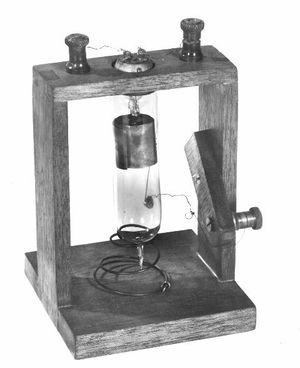Milestones:Poulsen-Arc Radio Transmitter, 1902 and Milestones:Fleming Valve, 1904: Difference between pages
No edit summary |
No edit summary |
||
| Line 1: | Line 1: | ||
== | == Fleming Valve, 1904 == | ||
London, England Dedication: July 2004 [[IEEE United Kingdom and Republic of Ireland Section History|IEEE UKRI Section]] | |||
[[Image: | [[Image:Fleming Diode 0351.jpg|thumb]] | ||
''[[ | ''Beginning in the 1880s Professor John Ambrose Fleming of University College London investigated the [[Edison Effect|Edison effect]], electrical conduction within a glass bulb from an incandescent filament to a metal plate. In 1904 he constructed such a bulb and used it to rectify high frequency oscillations and thus detect wireless signals. The same year Fleming patented the device, later known as the '[[Fleming Valve|Fleming valve]].''' | ||
'''The plaque | '''The plaque is posted at the University College, London.''' | ||
John Ambrose Fleming, a British scientist and professor at University College in London, is credited with one of the most important developments in the history of electronics. Following his work as a consultant for the Edison Electric Light Company from 1881-1891, Fleming became a scientific consultant to the Marconi Wireless Telegraph Company in 1899. | |||
Fleming knew about, and had himself investigated, the [[Edison Effect|Edison Effect]], which had been discovered in 1883. Shortly after his groundbreaking work with the incandescent lamp, Thomas Edison was conducting an informal experiment with his innovation. When he introduced an extra electrode into the bulb, he realized that, even though the electrode wasn't part of the bulb's circuit, it could carry a current when it was of a positive potential relative to the filament. This so-called Edison Effect was later interpreted to be a flow of electrons from the hot filament to the extra electrode. | |||
Fleming used this phenomenon to rectify a weak wireless signal. The oscillations of a wireless signal are too rapid to cause a galvanometer needle to move, but if the tiny current flows in one direction only are sent to the galvanometer, it will show a signal. During one of his experiments, Fleming wired an old vacuum tube into a radio receiving circuit, and was able to achieve this effect. On 16 November 1904 Fleming applied for a patent for what he originally named an oscillation valve, and what later became known as the [[Fleming Valve|Fleming valve]]. | |||
While it had an immediate practical use in its ability to detect messages sent by [[Morse Code|Morse code]], the Fleming diode was more important as a precursor to a new tube. After reading Fleming's 1905 paper on his oscillation valve, American engineer [[Lee De Forest|Lee DeForest]] in 1906 created a three-element tube, which, it turned out, could function as an amplifier and oscillator as well as detector. Through its initial and future applications, the Fleming valve laid the foundation for the field of electronics. | |||
== Map == | == Map == | ||
{{#display_map: | {{#display_map:51.523033, -0.131607~ ~ ~ ~ ~University College, London, England|height=250|zoom=10|static=yes|center=51.523033, -0.131607}} | ||
[[Category: | [[Category:Computing_and_electronics|{{PAGENAME}}]] | ||
[[Category: | [[Category:Electronic_components|{{PAGENAME}}]] | ||
[[Category: | [[Category:Oscillators|{{PAGENAME}}]] | ||
Revision as of 17:56, 6 January 2015
Fleming Valve, 1904
London, England Dedication: July 2004 IEEE UKRI Section
Beginning in the 1880s Professor John Ambrose Fleming of University College London investigated the Edison effect, electrical conduction within a glass bulb from an incandescent filament to a metal plate. In 1904 he constructed such a bulb and used it to rectify high frequency oscillations and thus detect wireless signals. The same year Fleming patented the device, later known as the 'Fleming valve.'
The plaque is posted at the University College, London.
John Ambrose Fleming, a British scientist and professor at University College in London, is credited with one of the most important developments in the history of electronics. Following his work as a consultant for the Edison Electric Light Company from 1881-1891, Fleming became a scientific consultant to the Marconi Wireless Telegraph Company in 1899.
Fleming knew about, and had himself investigated, the Edison Effect, which had been discovered in 1883. Shortly after his groundbreaking work with the incandescent lamp, Thomas Edison was conducting an informal experiment with his innovation. When he introduced an extra electrode into the bulb, he realized that, even though the electrode wasn't part of the bulb's circuit, it could carry a current when it was of a positive potential relative to the filament. This so-called Edison Effect was later interpreted to be a flow of electrons from the hot filament to the extra electrode.
Fleming used this phenomenon to rectify a weak wireless signal. The oscillations of a wireless signal are too rapid to cause a galvanometer needle to move, but if the tiny current flows in one direction only are sent to the galvanometer, it will show a signal. During one of his experiments, Fleming wired an old vacuum tube into a radio receiving circuit, and was able to achieve this effect. On 16 November 1904 Fleming applied for a patent for what he originally named an oscillation valve, and what later became known as the Fleming valve.
While it had an immediate practical use in its ability to detect messages sent by Morse code, the Fleming diode was more important as a precursor to a new tube. After reading Fleming's 1905 paper on his oscillation valve, American engineer Lee DeForest in 1906 created a three-element tube, which, it turned out, could function as an amplifier and oscillator as well as detector. Through its initial and future applications, the Fleming valve laid the foundation for the field of electronics.
